
Title: Pioneer Auto Museum and Antique Town, Murdo, South Dakota
Creator: S.D.) Pioneer Auto Museum (Murdo
Release date: June 7, 2021 [eBook #65547]
Most recently updated: October 18, 2024
Language: English
Credits: Stephen Hutcheson and the Online Distributed Proofreading Team at https://www.pgdp.net

Murdo, South Dakota
PIONEER AUTO MUSEUM and A. J. “Dick” Geisler are a single thought in the minds of many who have visited and had the chance to know the man with the ever-present cigar. A Valentine present to German immigrant parents, Dick knew he and the family farm were not cut out for each other. He attended a rural school near New Ulm, Minnesota much like the one that is part of the museum. After high school his mother’s plans for business college for her son were interrupted by a job selling for the Jewel Tea Company, and other sales ventures. In 1923 he and a friend drove a Ford like the one to be seen in the Ford Garage from Minnesota to California taking odd jobs along the way to finance the trip.
In California he met and married Vivian Petersen who had traveled to California with her three sisters. The three Geisler children were born in Pasadena where “Dick” was operating the feed, hardware and appliance business he started in the height of the depression. In 1942 Mr. Geisler traded his California home for a farm near Blunt, South Dakota, sold the businesses and returned to the Midwest.
Crops had been nonexistent for some years prior to his move to South Dakota and the natives were amused at the West coast city dude who busily went about planting wheat. The Geisler touch and ideal conditions brought about the first of many banner years for crops in the area.
In 1945 “Dick” bought a John Deere Chevrolet dealership in Murdo and moved his family once again. In 1950 he opened the Phillips 66 gas station at the junction of U.S. 16 and 83. The embryo of the PIONEER AUTO MUSEUM took shape in the form of an old buggy and a 1913 Ford Peddler’s Wagon (now located in the Ford Garage) which were parked in front of the station and elicited considerable comment from tourists. As the years rolled by a vintage car here and an antique there were added to “Dick’s” small but growing collection. Dick’s son, John, made the first trip to pick up a car back east. Upon returning, John told his father about other cars to be had. By ones and twos the collection grew to where something had to be done to properly store and show the cars.
Pub. by The Goin Company, Box 746
Mitchell, South Dakota 57301
MADE BY
DEXTER PRESS
WEST NYACK, NEW YORK

Pioneer Auto Museum
Murdo, South Dakota
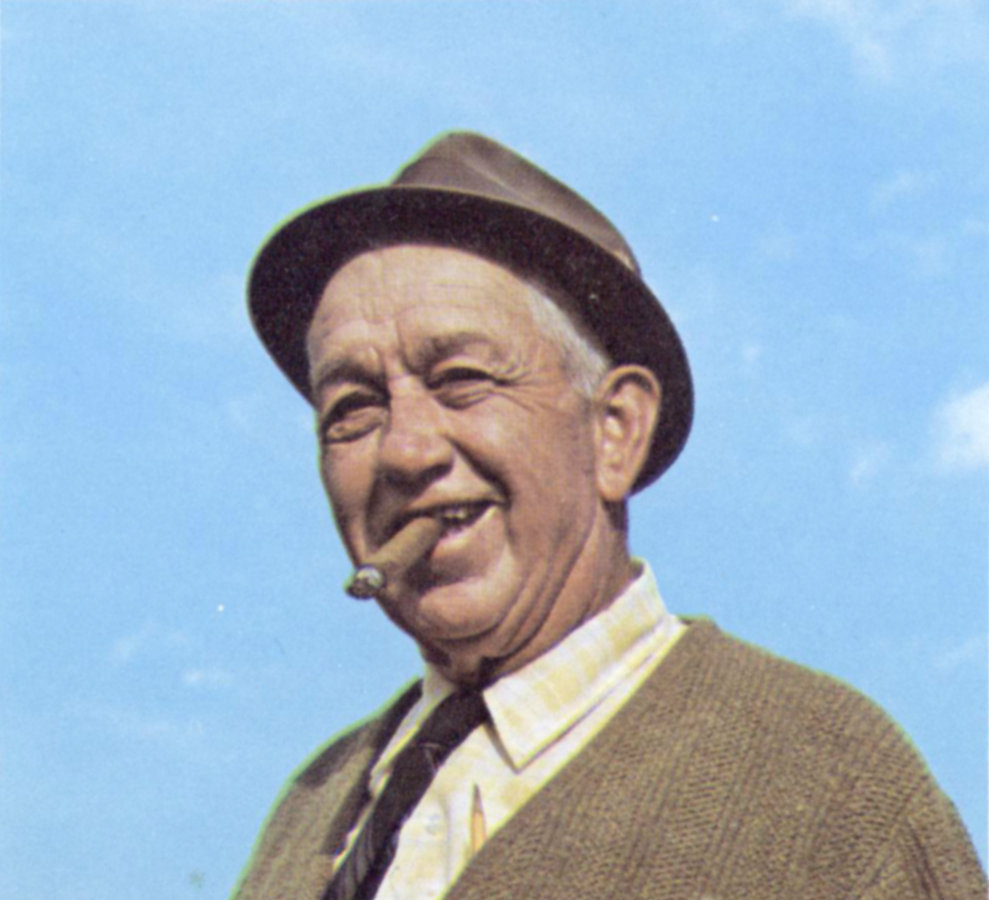
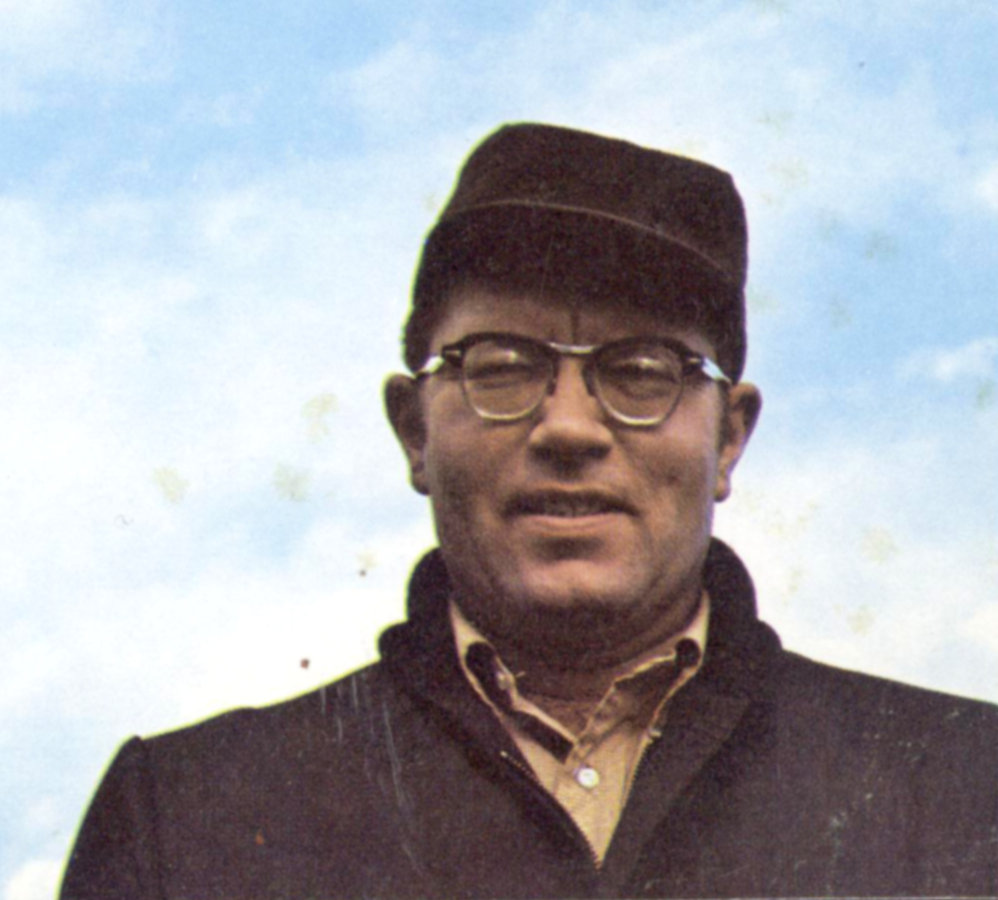

1903 Cadillac
With $750.00 you were in the driver’s seat of this gem in 1903. This first model made by the Cadillac Motor Car Co. of Detroit sported a single cylinder, under-the-floor mounted engine with a two speed transmission.
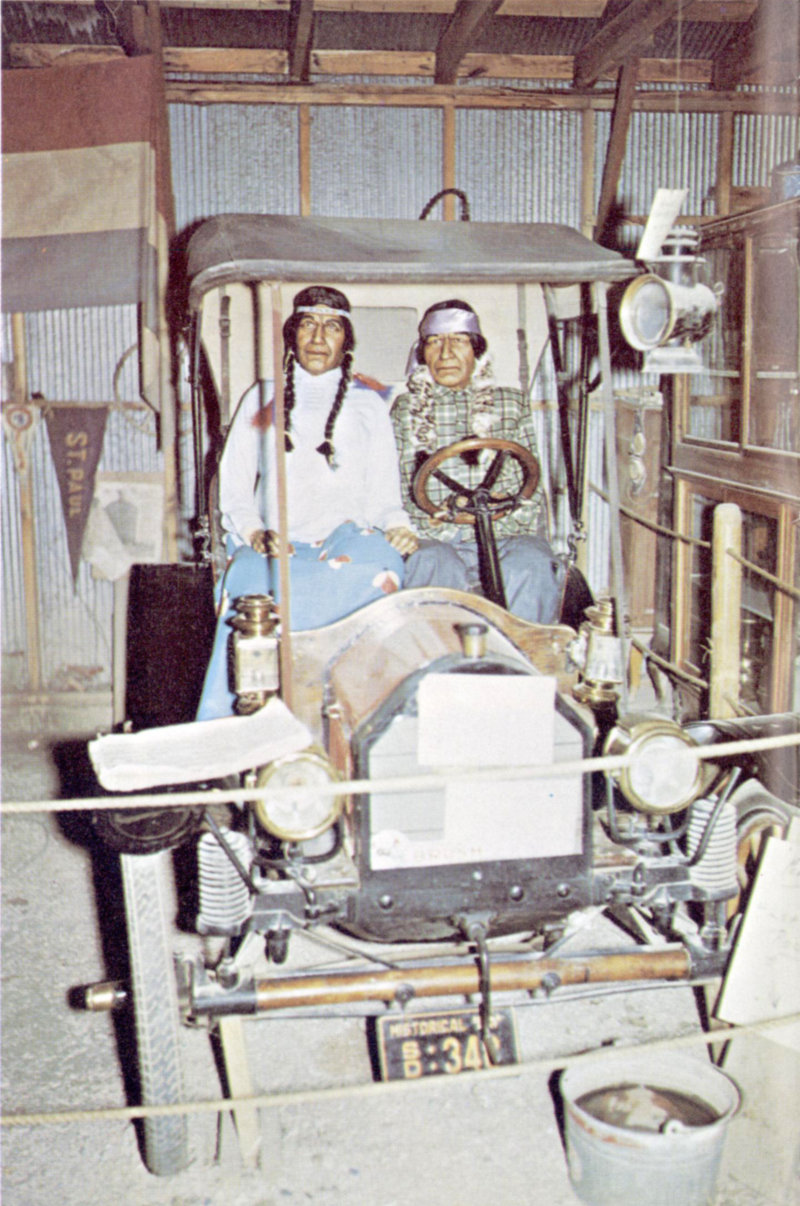
1908 Brush
This two passenger runabout was one of the popular models of its day. Built between 1907-1913, it had a wooden frame and wooden axles, coil springs on all four wheels and was chain driven. Its single cylinder 12 H.P. engine cranked counterclockwise. Sold new for $485.00. NOTE: The same man, Alanson P. Brush, designed the engines for both the Cadillac and Brush described on this page.
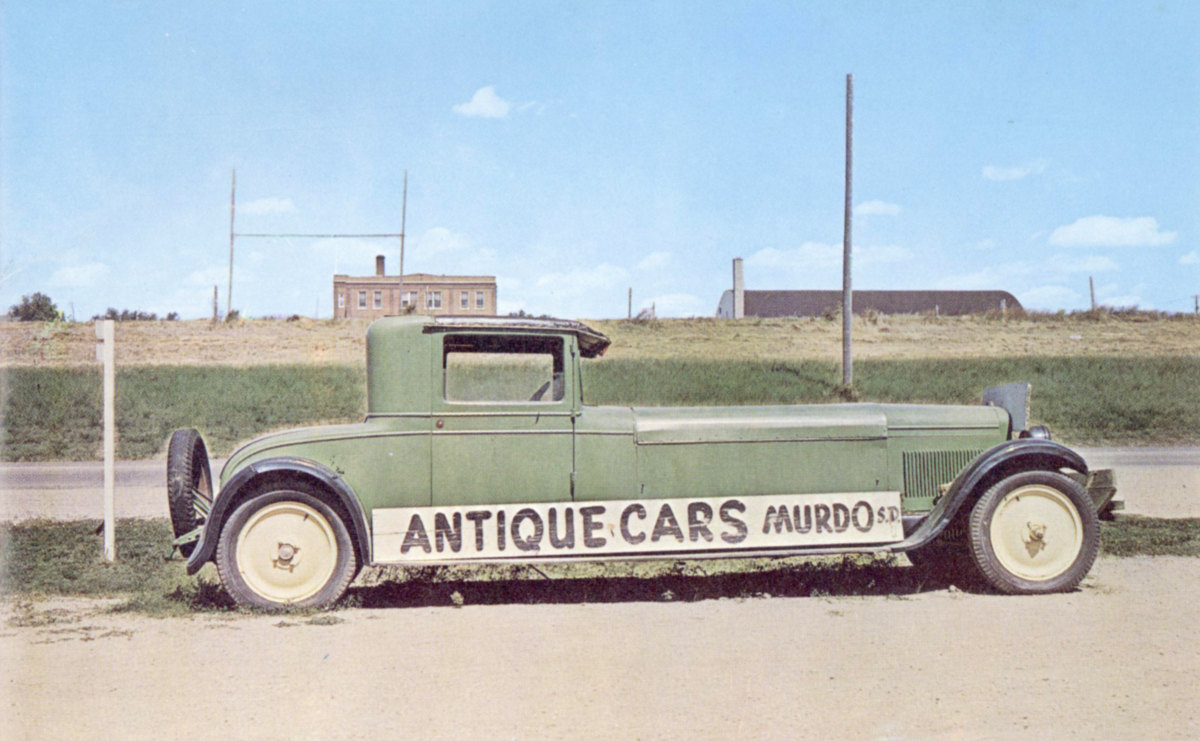
Long Green Car
Long enough to be a 32 cylinder monstrosity, this 1926 Nash was especially built as an eye-catcher. In identifying the Pioneer Auto Museum, reference is often made to this car.
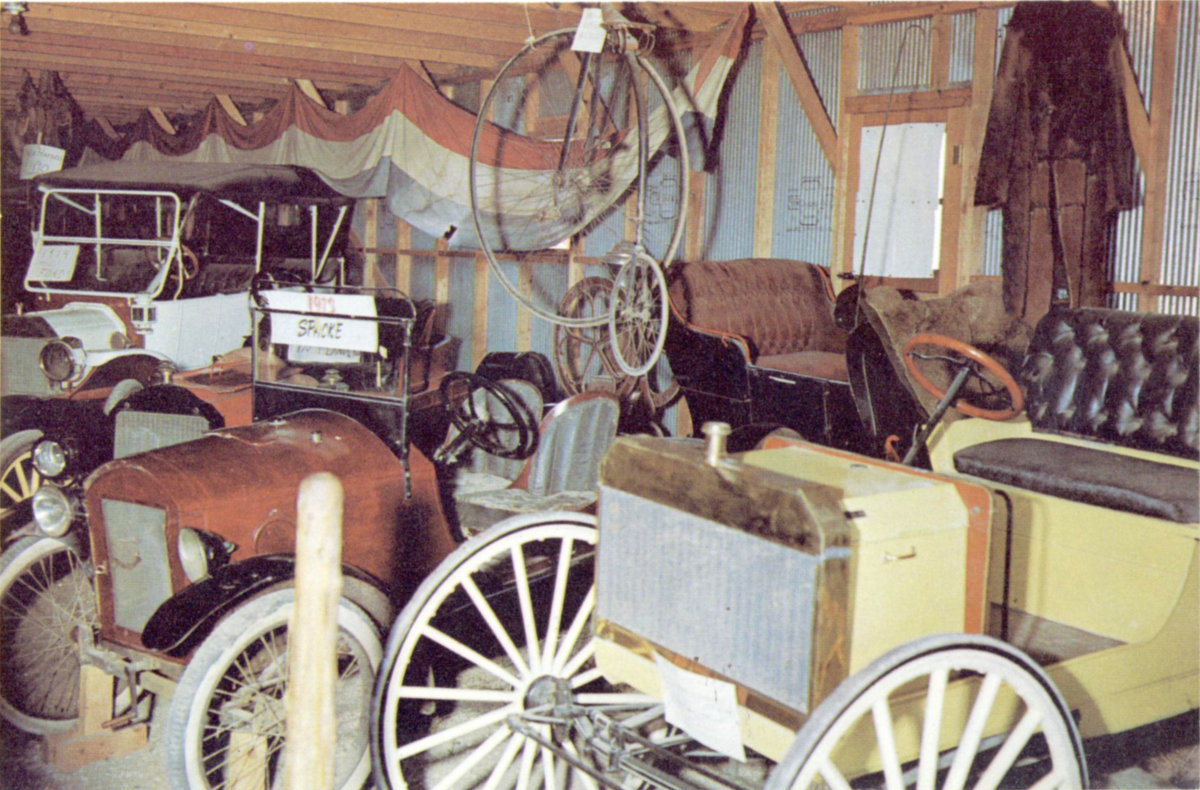
A Lineup of Old-Timers
A sample of man’s mechanical genius found in the Pioneer Auto Museum. In this lineup, left to right, can be seen a Model T, Flanders, Spacke, and Schacht.
ANTIQUE CARS
Wide variances of opinion exist as to what constitutes an antique car. To those unknowledgeable in history of the automobile it is often merely a relative description of an old car. The Veteran Motor Car Club of America classifies any car over 35 years old as antique. The Antique Automobile Club of America considers all pre-1930 models qualifying as antiques. The Horseless Carriage Club limit their choices for antique designation to pre-1916 cars. As we said, the term is somewhat relative.

1912 Chalmers
This high-wheeled, 4 cylinder speedster is a fine example of an early sports car. In 1910 Chalmers won the Glidden Trophy.
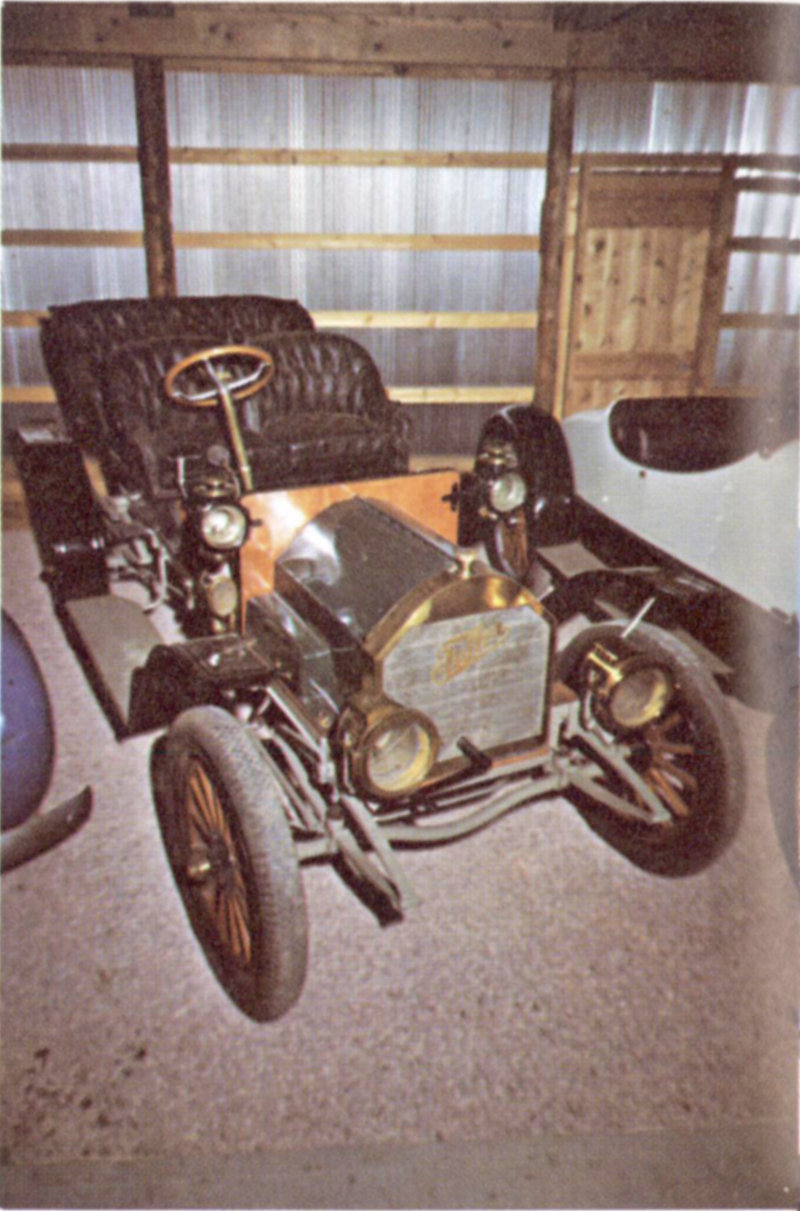
1909 Fuller
In 1909 and 1910 two companies were producing autos with the Fuller name—The Angus Automobile Company of Angus, Nebraska and the Fuller Buggy Company of Jackson, Michigan. The inflatable tires identify this model as being made in Jackson, Michigan.
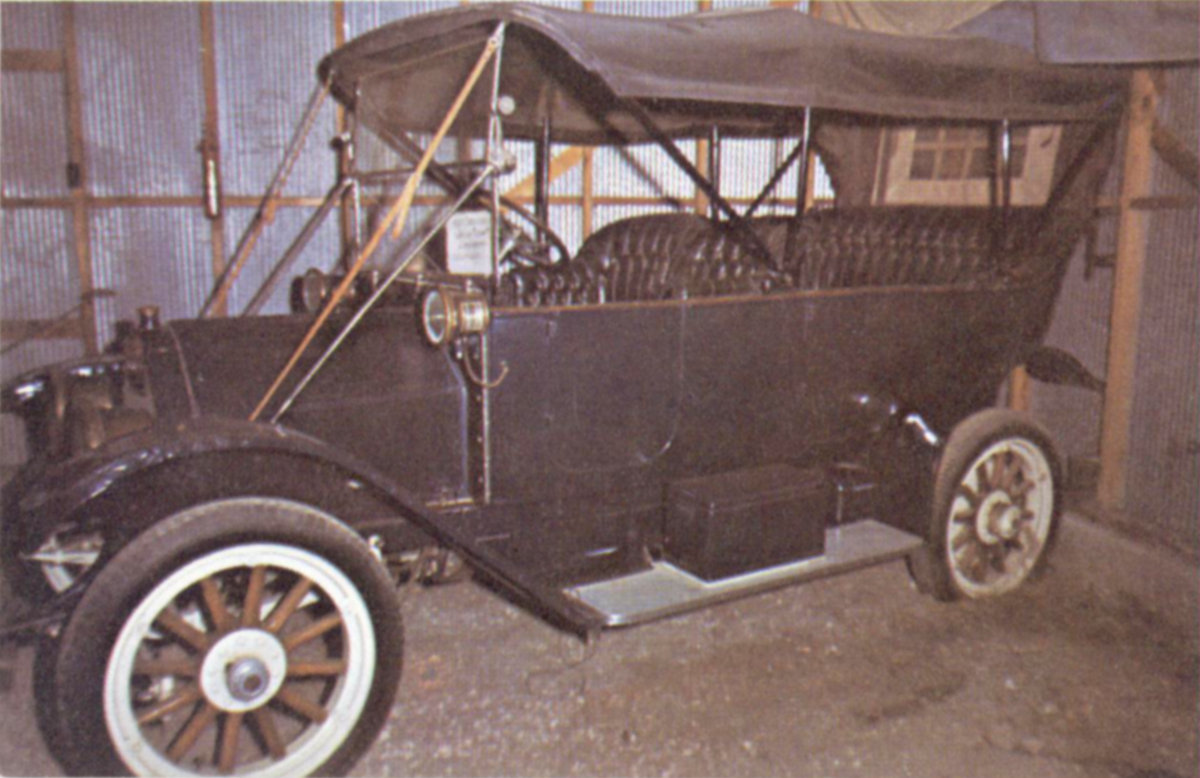
1912 Cadillac
This gleaming blue beauty must have brought joy to the heart of its first owner. The brass lamps and leather workings show great care. Note the early “bucket” seats.
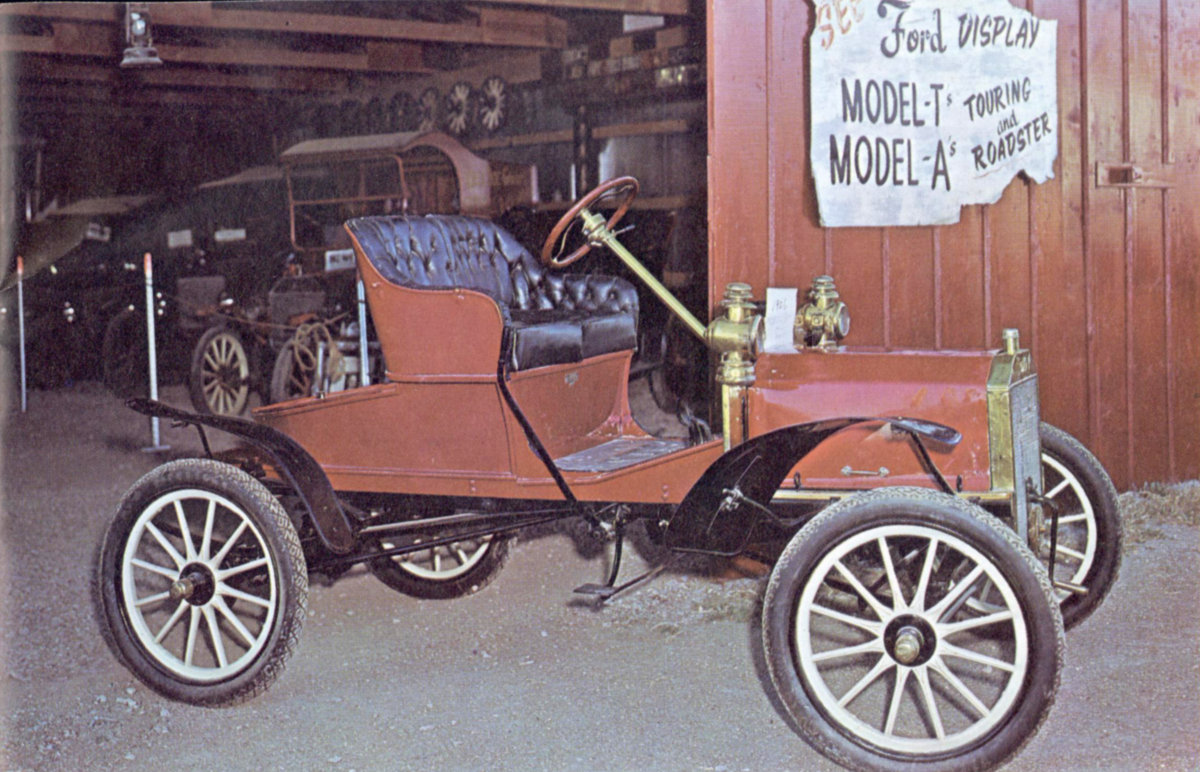
1906 “N” Ford
This early model come off the line just three years after Henry Ford produced his first auto. It is the first car to be seen as you enter Henry’s Ford Garage.
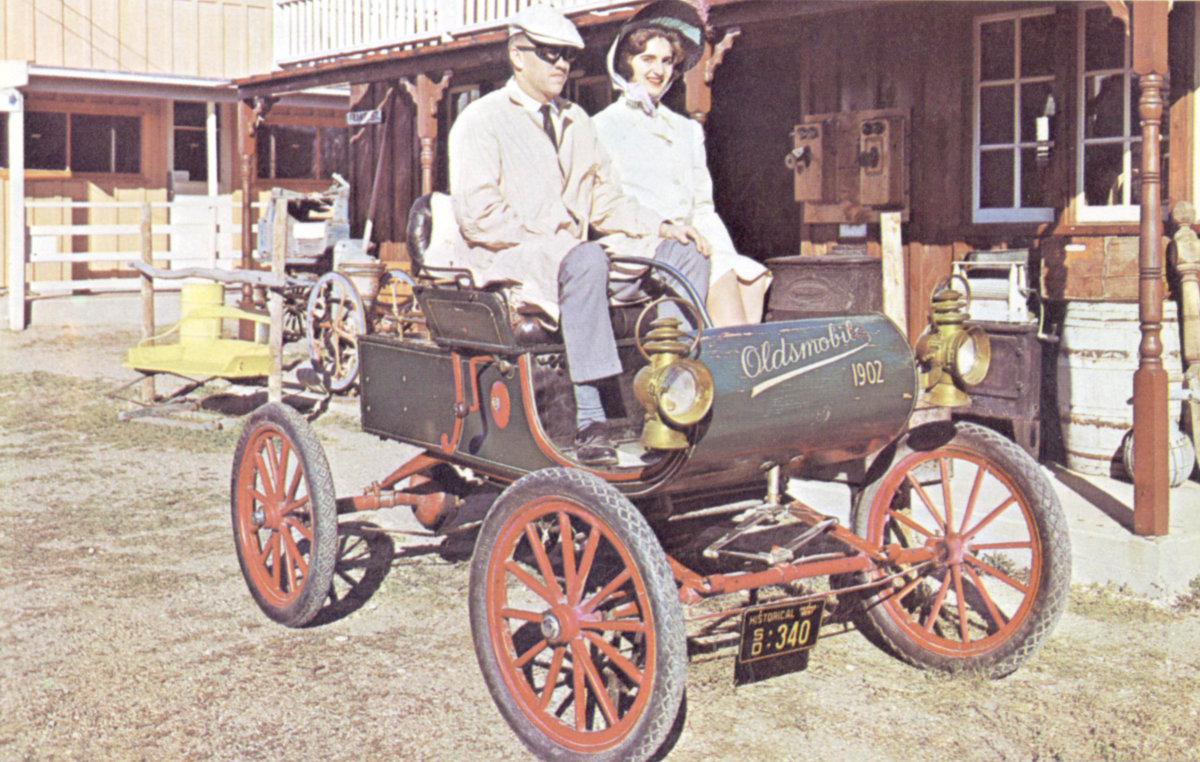
1902 Oldsmobile
This curved dash Olds was powered by a single cylinder engine and steered with a tiller. It was the world’s first mass produced automobile.

1902 Schacht
A 1902 gem with double chain drive. This hard wheeler was one of the earlier models with a steering wheel. Note the hand crank in back for the rear-mounted motor.

1917 Hupmobile Roadster
Very few of this model are found today. This 4 cylinder roadster was capable of 45 miles an hour and sold for $1,265.00 new. What is now known as the antique era was rapidly coming to a close and many of the refinements of production efficiency can be noted on this car.
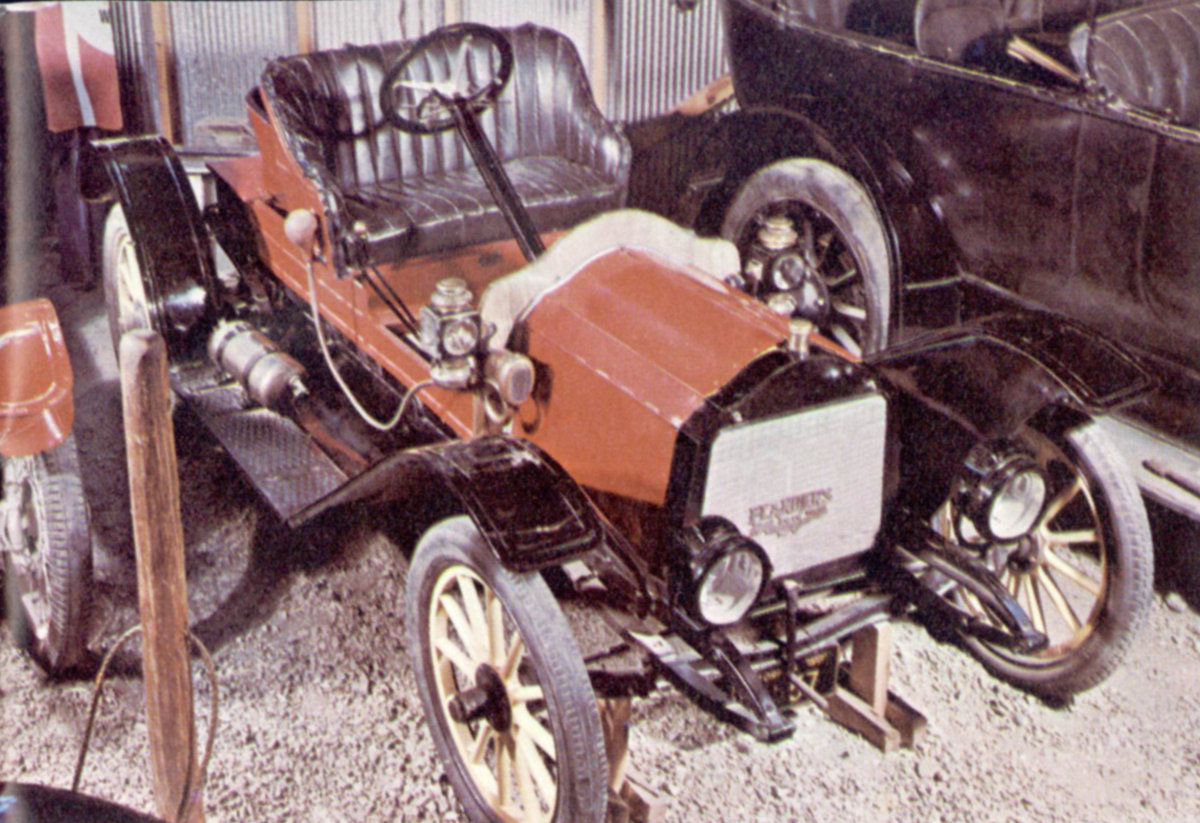
1910 Flanders
The Flanders was marketed by Studebaker and remained unchanged for the years of its manufacture, 1909-1912. It has a 4 cylinder engine and a 3 speed transmission. This model was noted for its mother-in-law seat, a single seat in the rear.
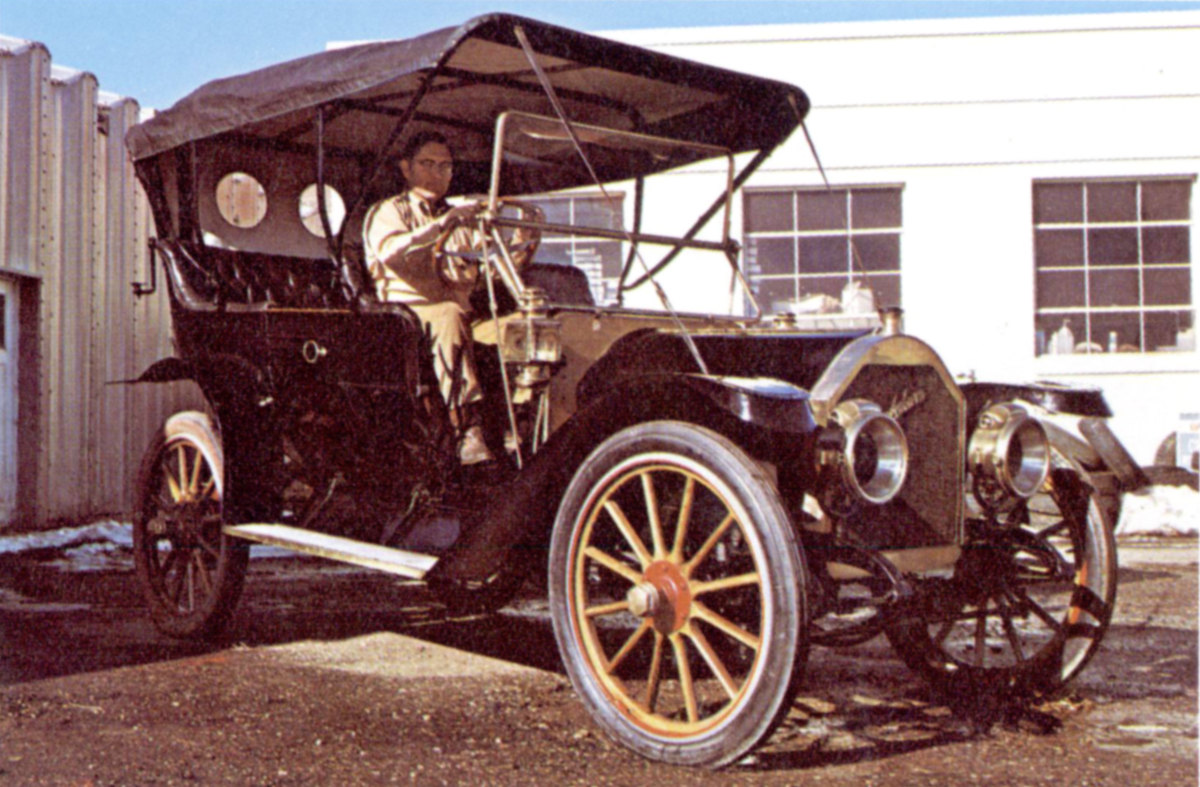
1909 Auburn Touring
If cars could speak, this particular Auburn could tell much of the early history and settling of Central South Dakota. It was used for many years to transport settlers to their claims, some a full day’s ride from Murdo. Fully restored in early 1971, it is now on display.
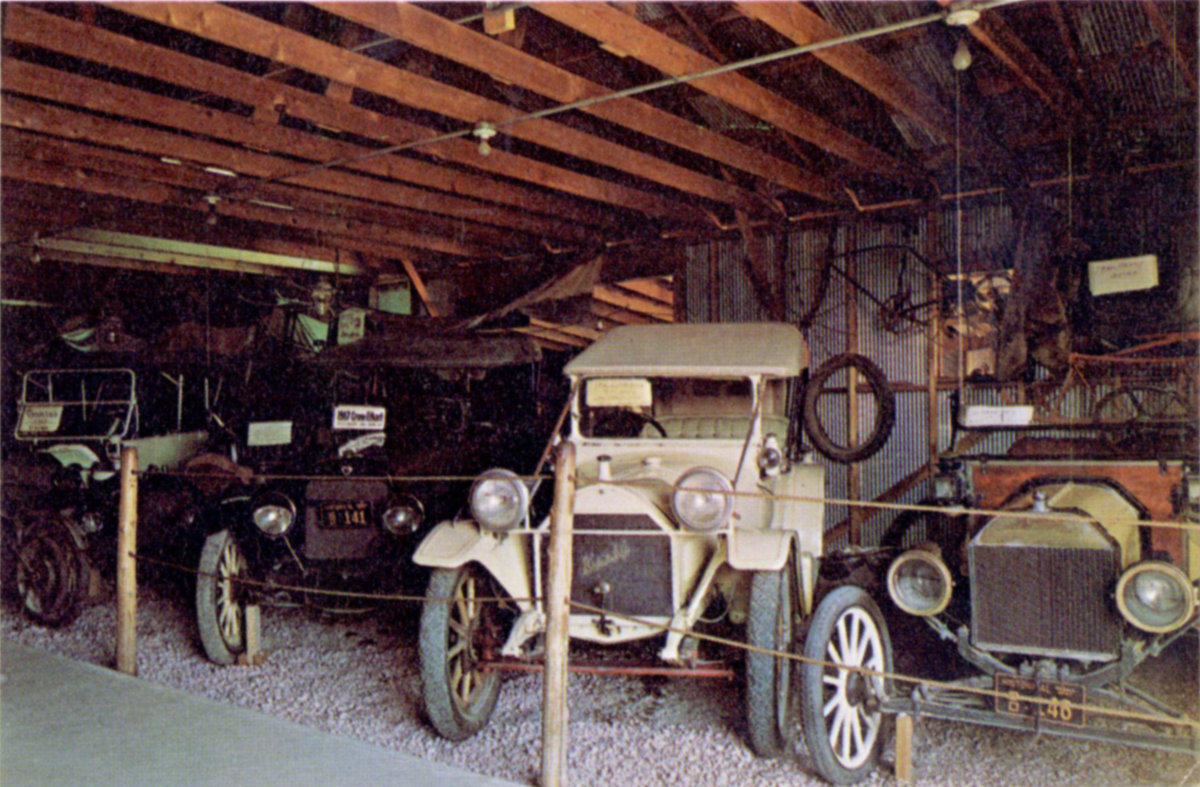
Autos On Review
From left to right—1914 Ford Touring, 1917 Crow-Elkhart, 1913 Hupmobile and a 1913 Ford Speedster.
Following World War I cars that had remained drawing board dreams sprung into reality. Faster production methods had evolved from the war and were now applied to the auto industry. New techniques for making lighter alloys were brought into use and new advances in the theory of the internal combustion engine were tested and applied. The result was a selection of autos superior to those of the previous period.
Production had passed from experiment to refinement. Efficiency was the byword with great care given in the construction of each unit during that post-war period. Mass production sounded the death knell for the short-lived Vintage Years which, it is generally agreed, lasted from 1919 to 1930.

1922 Essex
This Essex, manufactured by the Hudson Motor Car Company from 1918-1932, was a low-priced, four cylinder car. However, it was very popular and was noted for its remarkable acceleration and top speed.
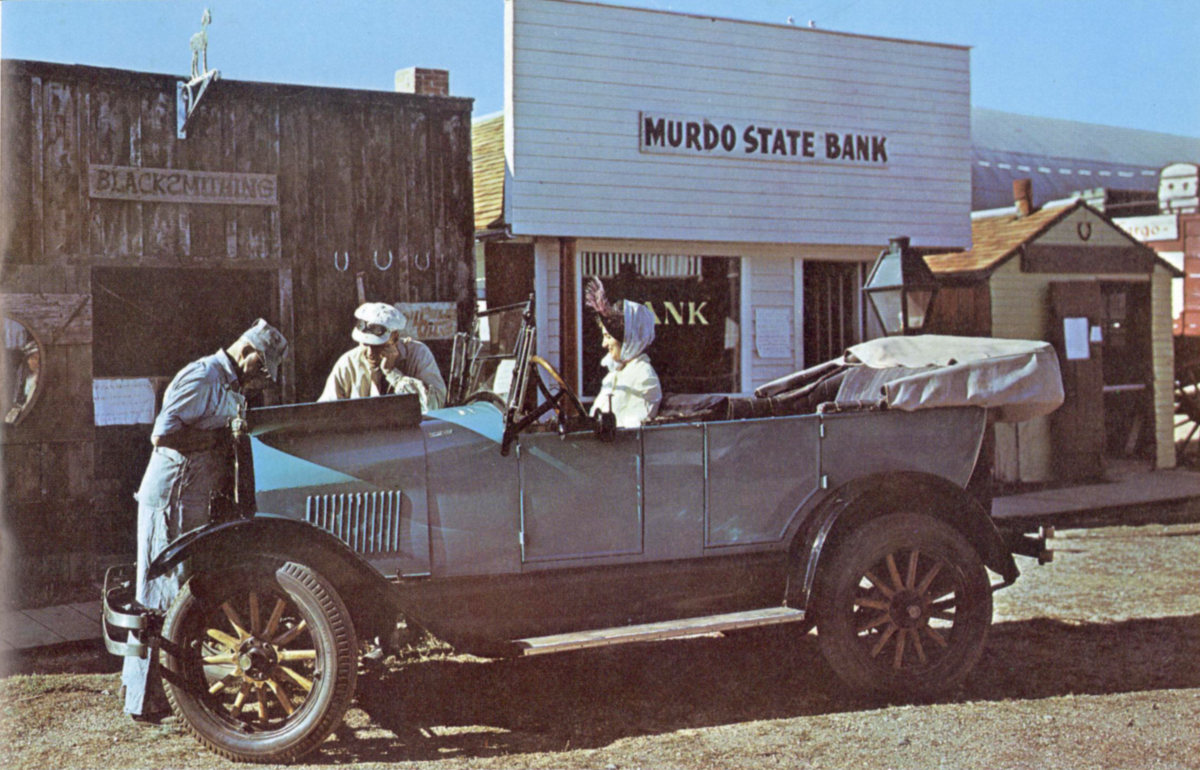
1922 Star Touring
Even the best of the Vintage Years autos had their bad moments. Experienced mechanics were few and far between in some parts of the country. Usually the local blacksmith could be depended upon for a piece of bailing wire and a fair repair job, as on this 1922 Star.
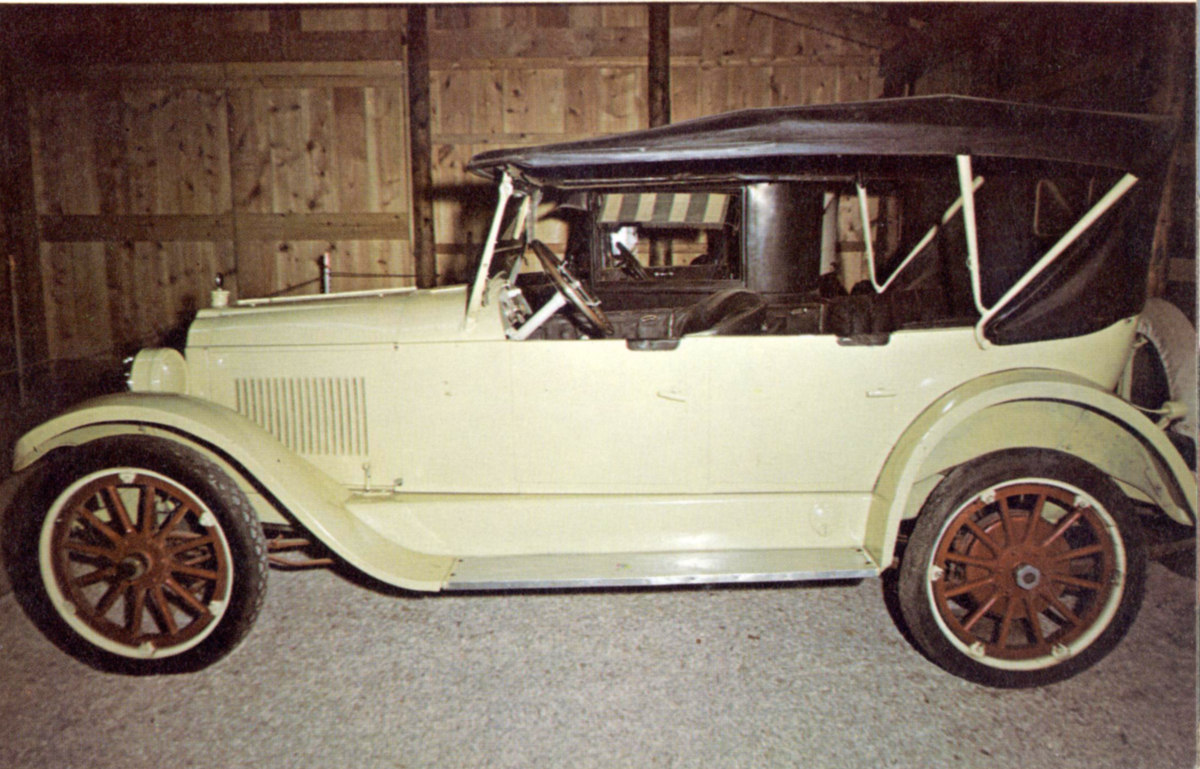
1927 Willys-Knight
Willys-Knight was most notable for its double-sleeve-valve engine. Purchase price for this model was $1,400.00.

1922 Stutz Touring
You were really “IN” back in the “Roaring 20’s” with this sporty wire-wheeled model. This is a blood-brother to the famous Stutz Bearcat of early sports car fame.
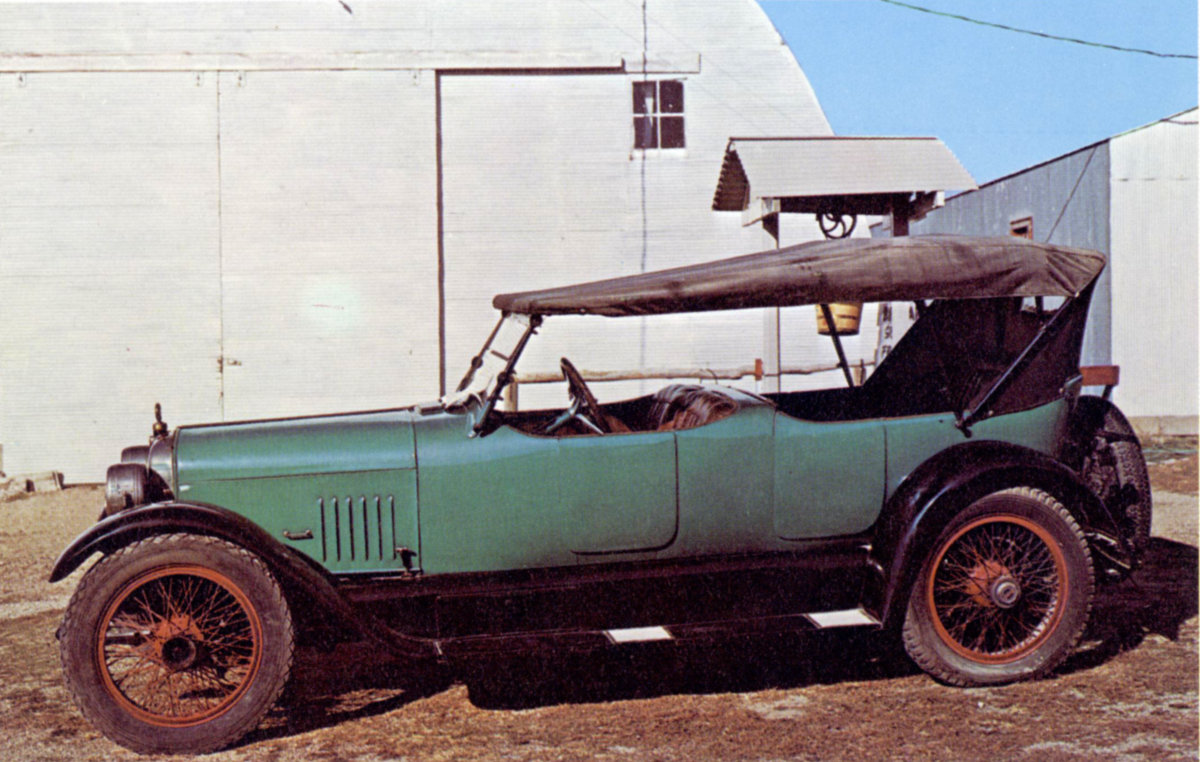
1922 Mercer Touring
The tour cylinder Mercer was one of the fastest cars of its day. Note the wire wheels and the two spare tires at the rear. All four doors opened from the inside only.
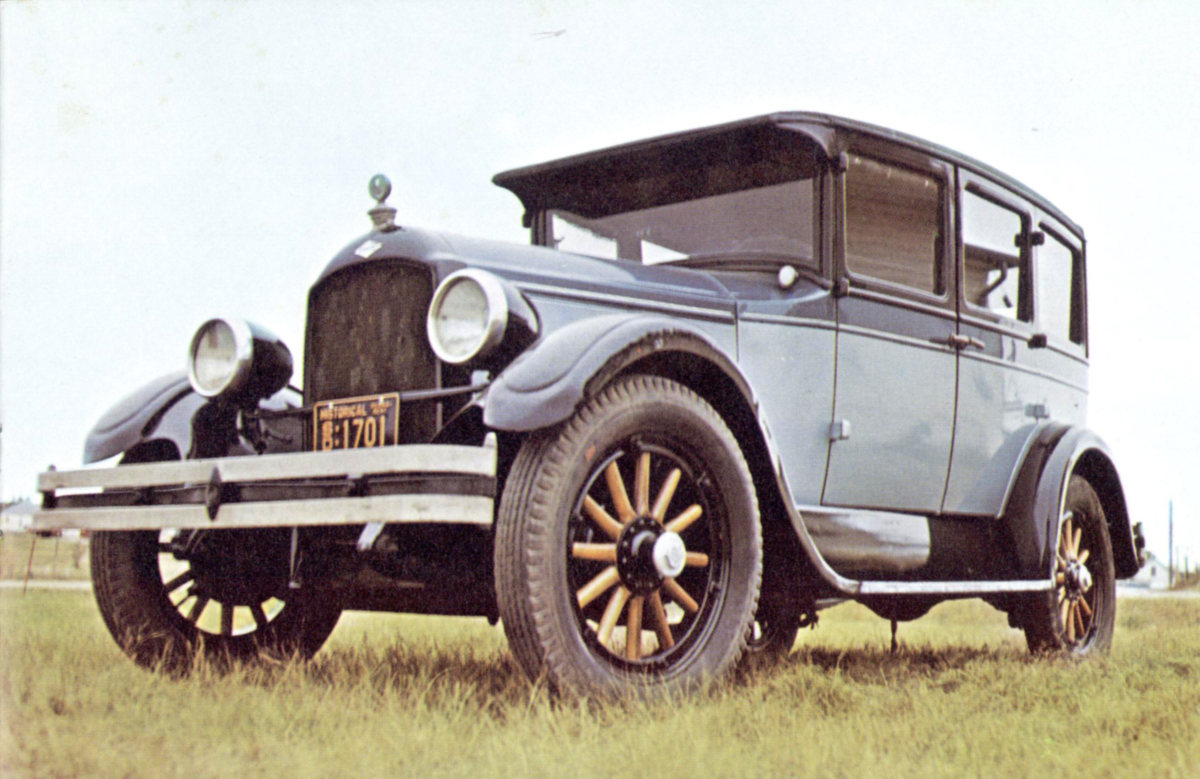
1928 Paige-Detroit
This six cylinder four door sedan was one of the last cars made by the Paige Company which merged with the Graham Brothers Company the next year forming the Graham-Paige Company. Notice the three-tone paint job.
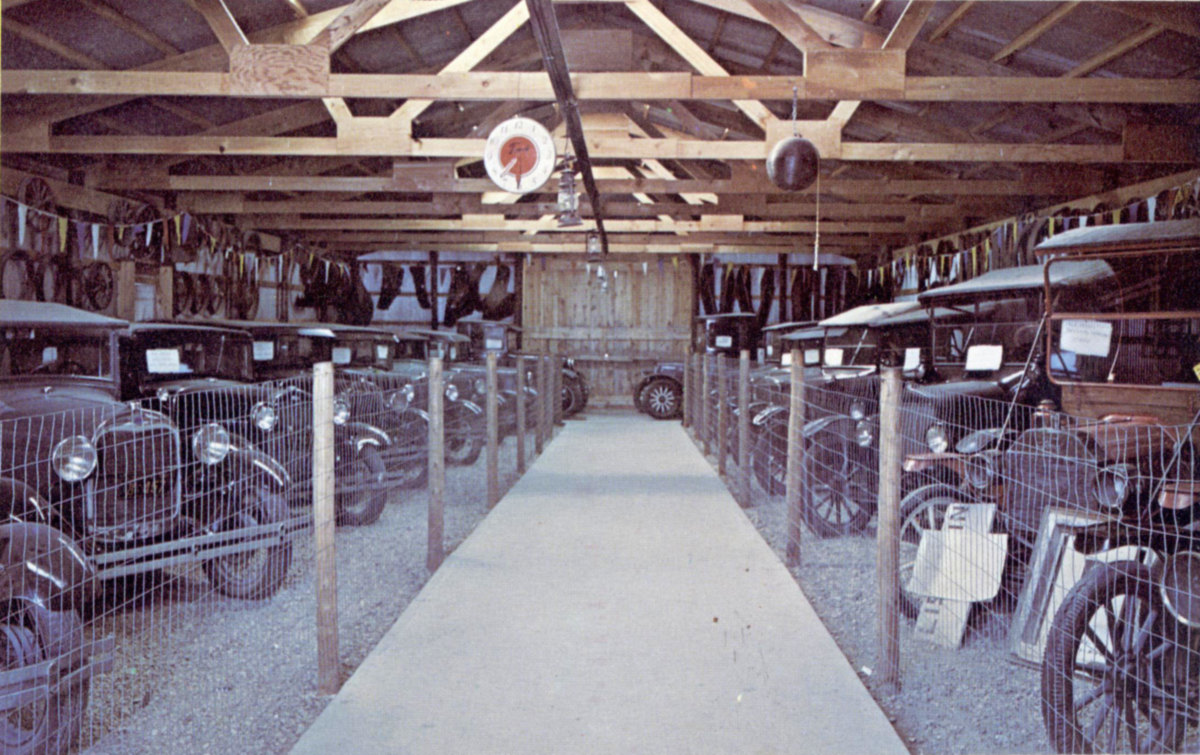
Henry’s Ford Garage
Henry’s Garage displays 18 early Fords from the 1906 Model “N” through the Model A”. A parts room duplicating the organized mess of the early Ford parts department and a display of tools used to work on these wonders which would go miles with baling wire or a hair pin holding them together.

1913 Overland
Mr. Geisler is sentimental about every car in his collection but this one has a special place in his heart. Can you remember the first car you ever drove?—Here is the first car Dick Geisler drove, now restored to prize winning condition. It was judged the finest example of restoration in 1963 and received a first place trophy at the national meet held by the Antique Automobile Club of America that year.
What does set apart a true classic from a standard production car? Two things in principle: Brilliant and unusual design coupled with the most advanced engineering of the day. Almost inseparable from these attributes are two more basic factors: Superlative hand workmanship and limited production. Some classics may excel in body design coupled to a lesser standard of engineering or vice versa, but all the above qualities are invariably found in a true classic.

1928 Cunningham
James Cunningham & Sons manufactured finely made, luxury cars in Rochester, N.Y. between 1907 and 1936. This early example of the V-8 engine produced 100 bhp at 2400 rpm. The Cunningham sold for up to $9,000.00. In 1970 a close-coupled convertible like this one was offered for $38,750.00. Early Cunningham enthusiasts included Mary Pickford, Marshall Field, William Randolph Hearst and Harold Lloyd. This car was driven for half its trip from Wisconsin to the PIONEER AUTO MUSEUM.
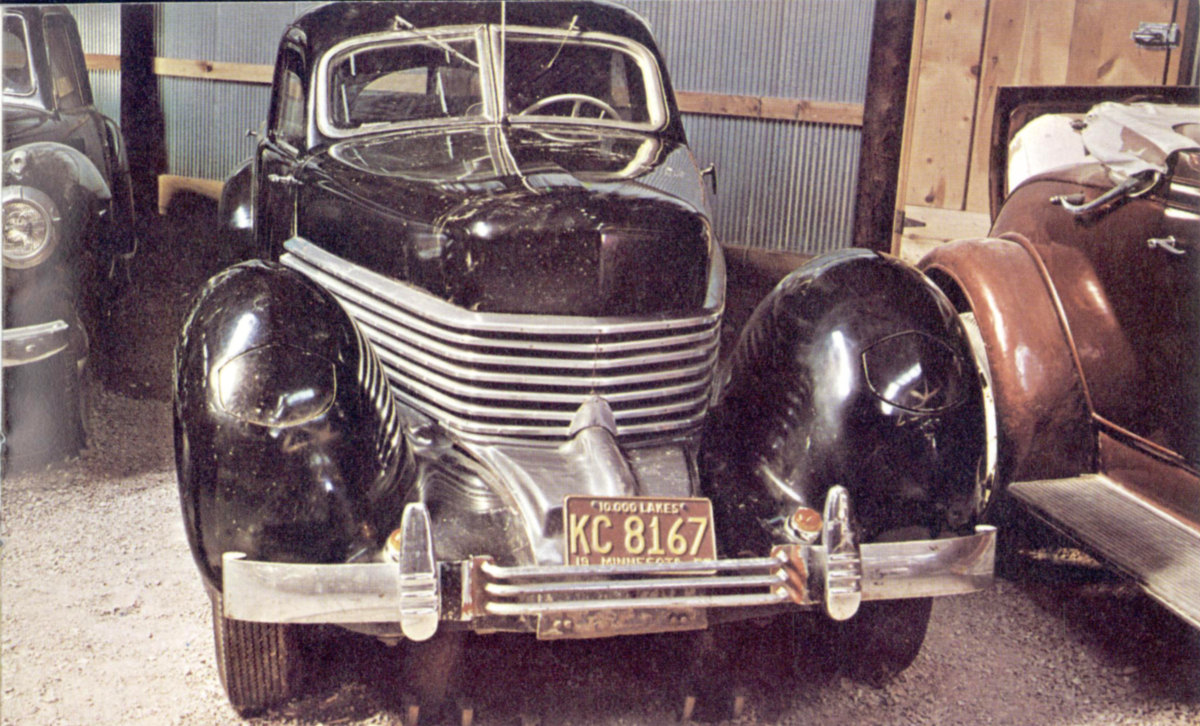
1937 Cord
This 810 Westchester Sedan was manufactured by Auburn Automobile Company. Only 2,320 cars of the 810 and 812 model Cord were made. It featured front wheel drive, Lycoming V-8 engine, retractable headlights and wrap-around grill. A 1937 supercharged model 812 originally sold for $3,575.00. A supercharged Beverly Sedan is on display in another building.

1931 Pierce-Arrow Convertible Coupe
Headlights sweeping from the fenders in clean, flowing lines mark it as a Pierce-Arrow. Bore and stroke were 3½ × 5 inches with a piston displacement of 385 cubic inches developing 132 horsepower. Another unique feature was pairs of coils, points and condensers allowing the 8 cylinder engine to run on four cylinders should the ignition fail. Many other unique features of engineering and design mark the Pierce-Arrow as a true Classic.

1932 Auburn Boattail Speedster
This classic beauty manufactured by the Auburn Automobile Company between 1903-1937 was guaranteed to have been test driven at more than 100 mph. Auburn first began using the two-tone color scheme in 1925. This yellow and red beauty came with a straight eight Lycoming engine rated at 150 H.P. This car was a first place winner at the national Auburn-Cord-Duesenberg meet a few years ago.
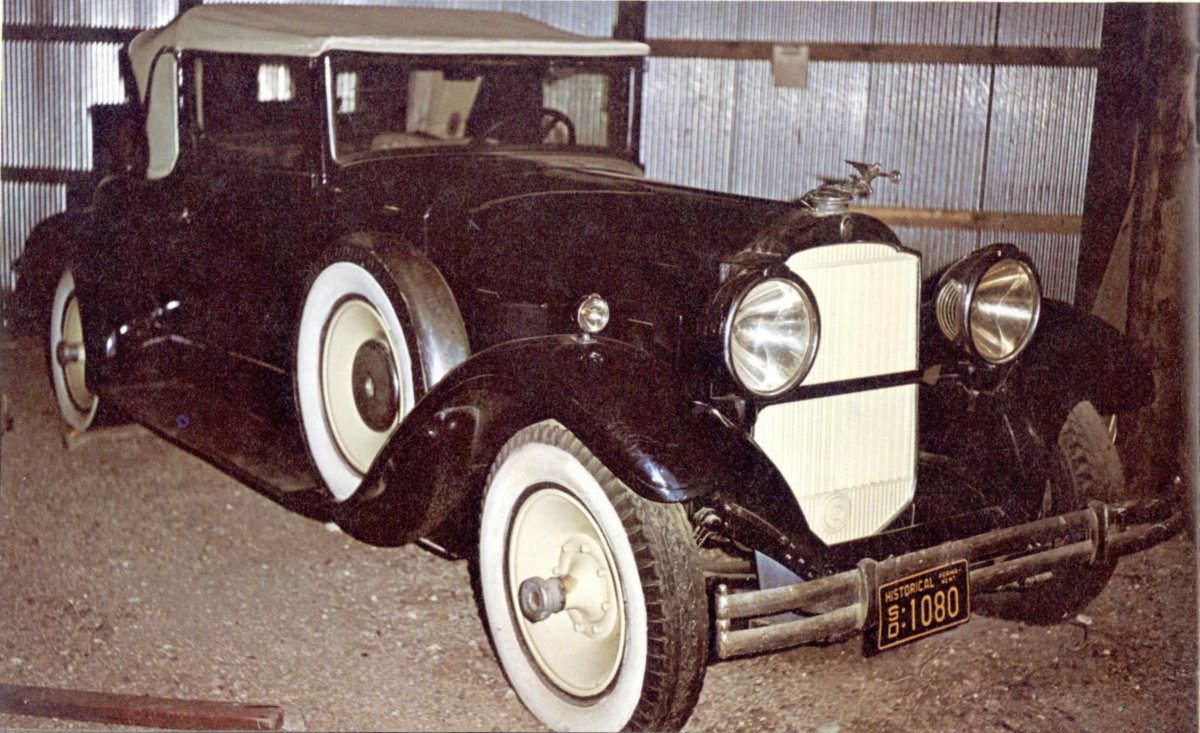
1928 Packard Convertible Coupe
This Packard has a straight eight engine, side-mounted spares, disc wheels, and a rumble seat. Two other Packards of this classic era, both four door phaetons, are also on display in the museum in the Classic Building.
To classify as a special interest car it should be distinguished either by unusual body style, an engineering innovation or some other marked difference from the routine production of its day. A few of the special interest cars to be found in the PIONEER AUTO MUSEUM are shown here.
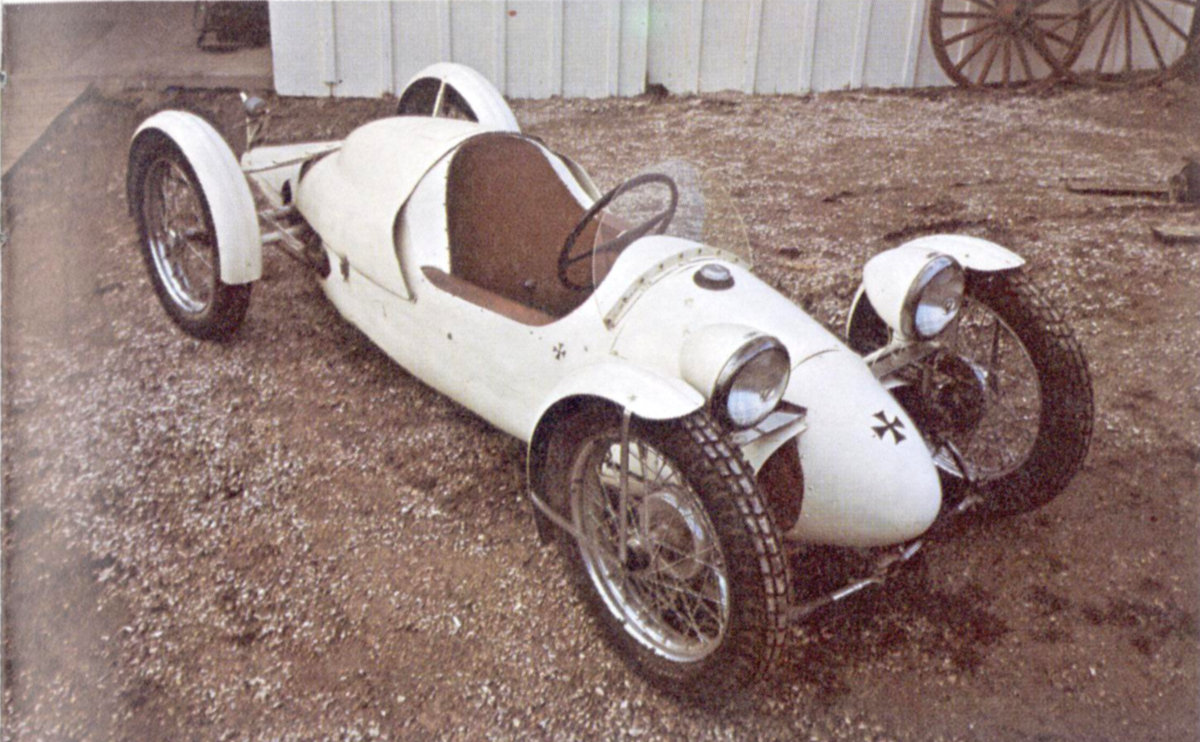
ROONEY RACER
The Mickey Rooney Racer was built especially for use in the movie “The Big Wheel.” It is powered by a motorcycle engine mounted in the rear. The car, bought in California, traveled cross country in its own tailor-made car top carrier.
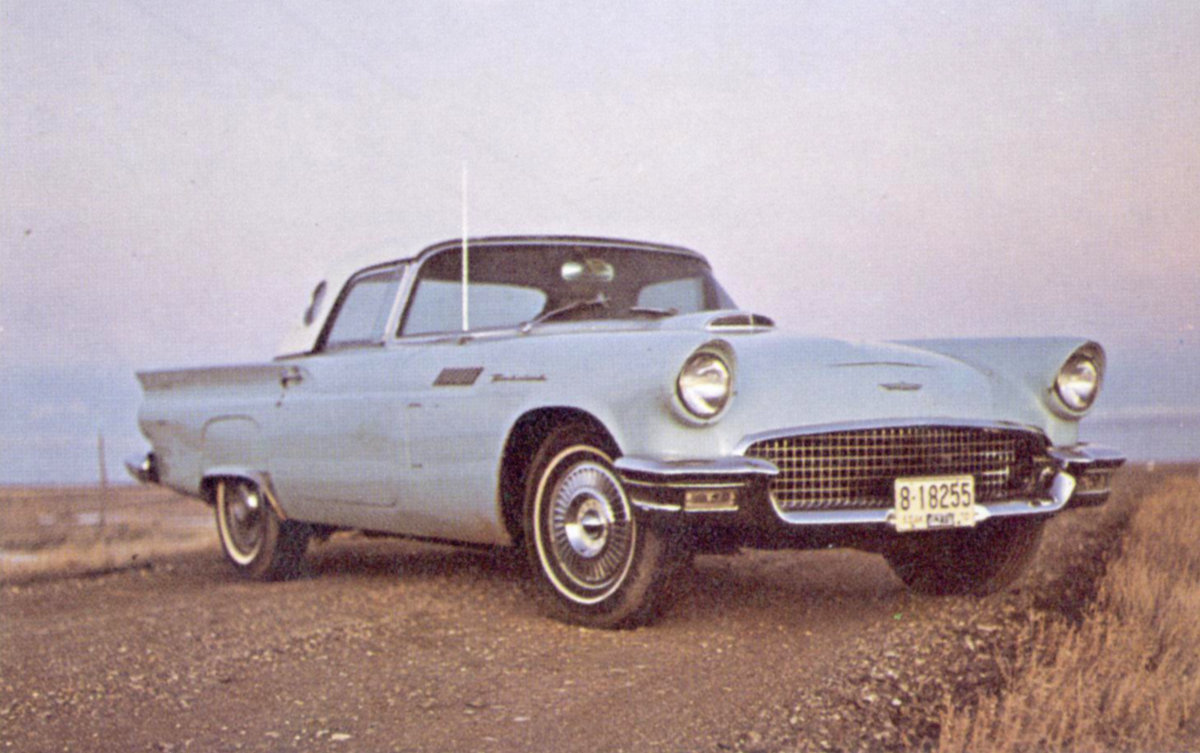
1957 Thunderbird
The two-seater Thunderbird was built between 1955-1957. The one on display at the MUSEUM has an engine with 312 cubic inch displacement. The porthole top is detachable, secured by five clamps and a convertible top was optional. This car is driven regularly by John Geisler, and may be parked in front of the MUSEUM.

Kaiser Darrin Roadster DKF-16
This true roadster manufactured by Willys Motors, Inc., boasts side curtains, hidden top, plexiglass wind wings, and sold for $3,668.00. The fibreglass body features doors that slide into front fender wells and an F head Willys engine. Of the 435 assembly line cars built only 226 are known to still exist. If you miss the car in the exhibit it is probably parked in front as it is driven regularly by Betty Geisler.

The Indian stared in amazement, dogs and kids ran for cover and great grandfather swelled with pride as he drove his new J. I. Case steam engine across the prairie.
The mechanical age had really arrived as these and many other smoke-belching behemoths rumbled across the plains of South Dakota years ago. The “dirt farmer” came into his own, turning over as many as 40 acres of virgin sod a day. He was soon to be recognized as the most important single factor in feeding a rapidly growing nation. Today’s farmer, heir to yesterday’s pioneer efforts, finds his role even more important. A hungry world constantly demanding a greater food supply leans heavily on the American farmer’s ability to produce more and more.
The giants pictured here have long since retired. But South Dakota is fortunate to have men of vision who have restored and maintained this part of our heritage to see and enjoy now and for years to come.
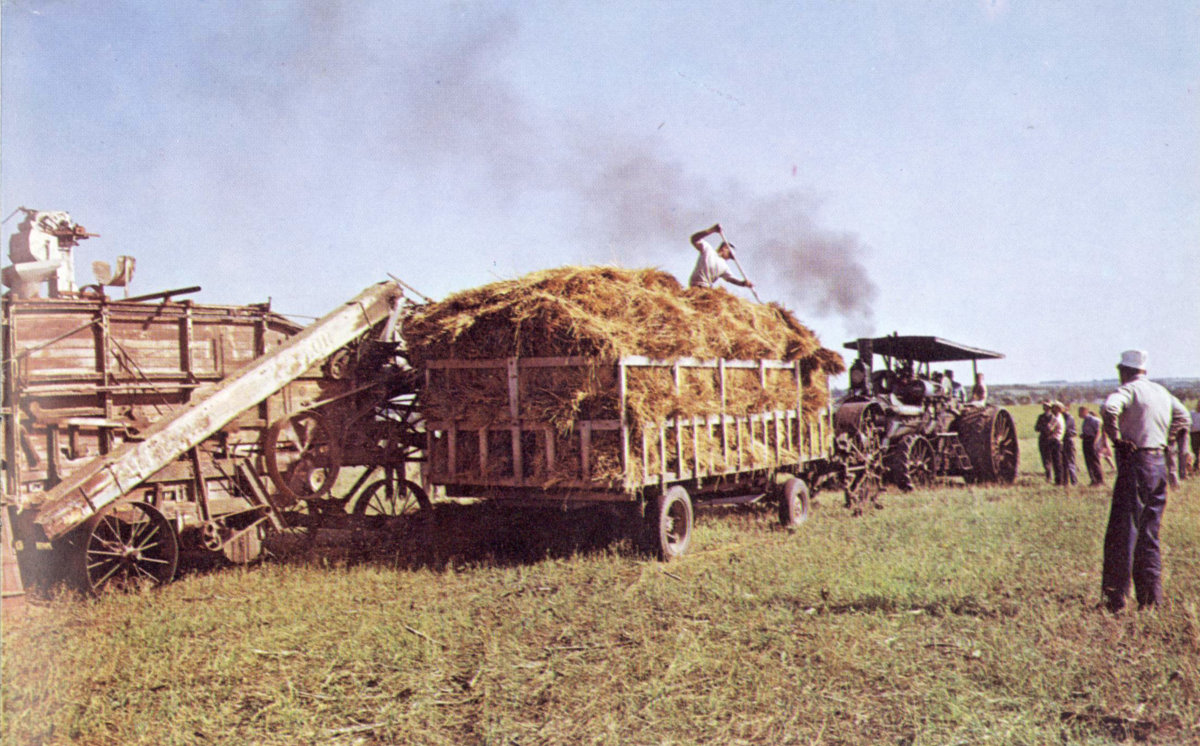
A Rumley Oil-Pull provides the power to drive one of the older threshing machines commonly seen in The wheat country of Central South Dakota. This steam powered behemoth provided belt drive to run the thresher.

An Aultman-Taylor kerosene powered tractor of yesteryear. Note the heavy chain behind the front wheels that provided the linkage for steering this giant. Typical of early equipment, it was all but silent until the drive train was engaged. No one was ever known to go to sleep at the switch.

Two views of the farm machinery lot at the back of the PIONEER AUTO MUSEUM. Dozens of tractors of all vintages are represented along with countless other pieces of farm equipment from days gone by.

“Remember way back when—?” and, “When I was a boy I used to walk five miles every day to a one room school back in—!” Here are reminders for those who have made these statements or heard them from the folks. A true turn-of-the-century main street. How different and complex are these same things today!

Two young ladies stand in front of the completely equipped barber shop. The other businesses appear to be closed for the day so one might guess father is still in the chair doing his part in a bit of close harmony.
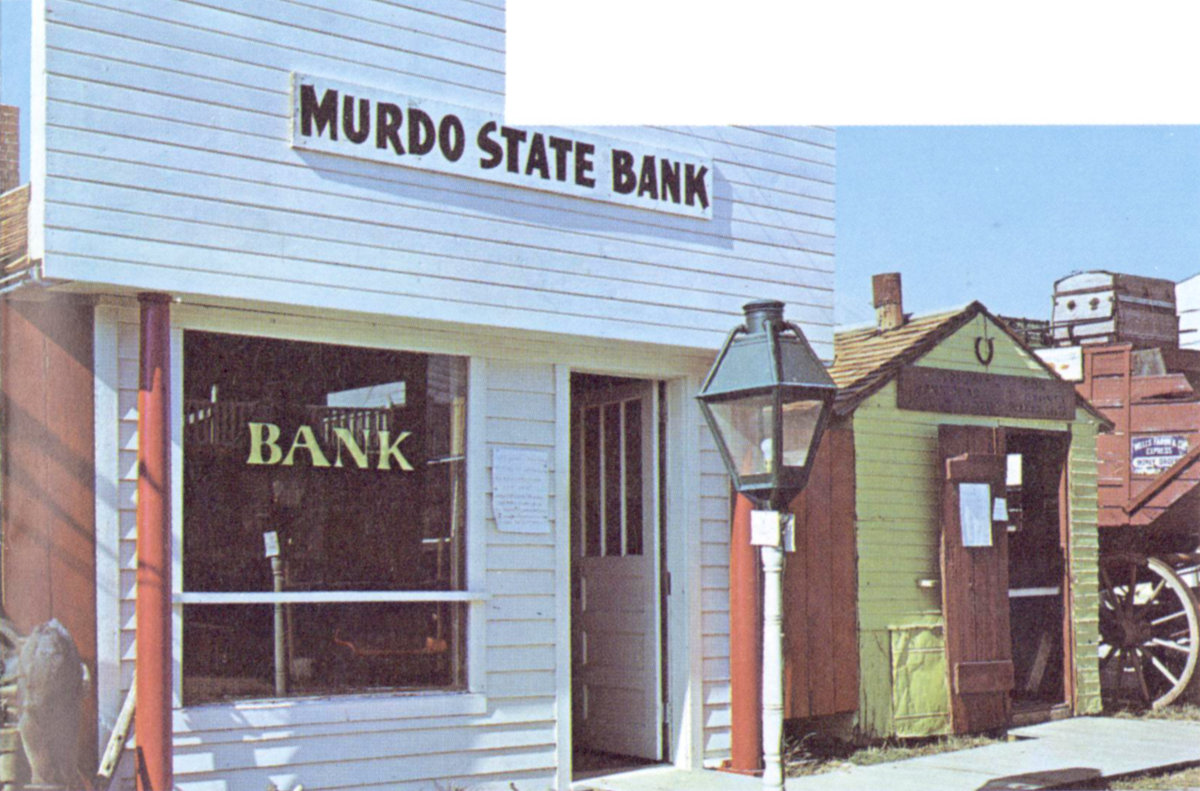
A bank is a bank—unless it’s the one you have done business with for years and it is to be dismantled. It could be Mr. Geisler “rescued his rescuer” when he bought the old Murdo State Bank, teller windows, equipment, safe and all. This was the local world of finance fifty years ago.
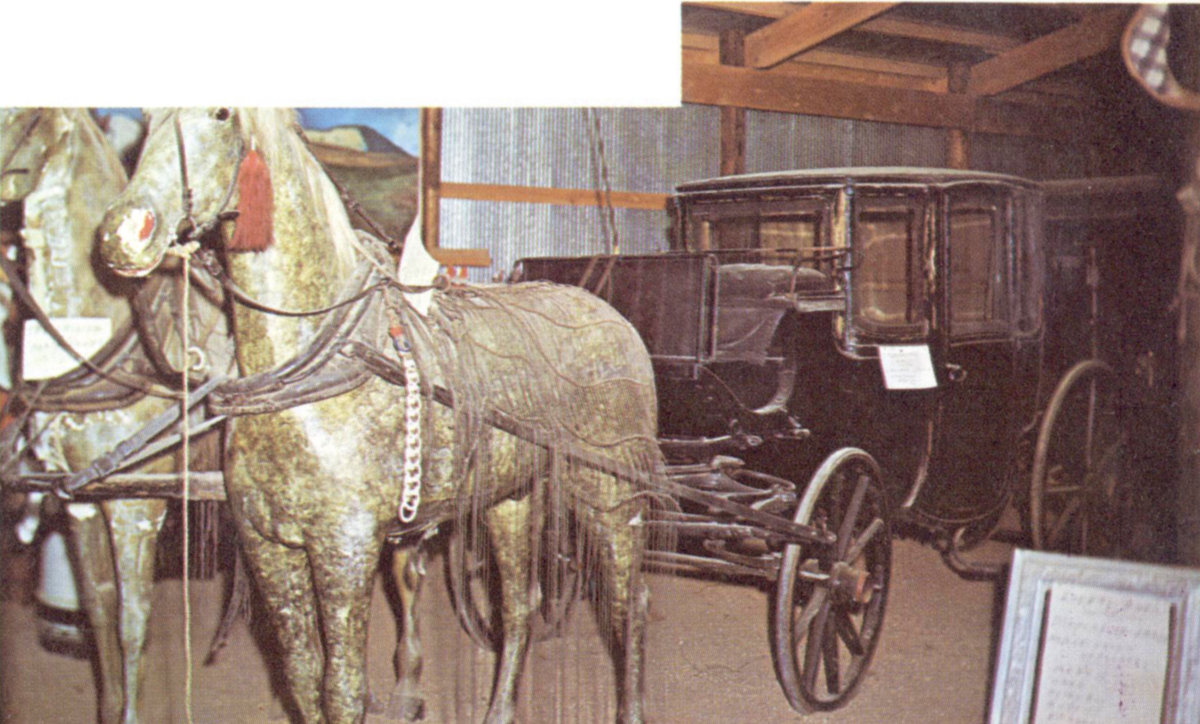
Funerals, weddings and fancy occasions saw this “hack” put to use. This is only one of the many interesting things to see in the Livery Barn at PIONEER AUTO MUSEUM.
Everything from barbed wire to groceries to clothing were on the shelves at the old General Store. The coffee grinder, the cracker barrel and the glowing pot-bellied stove are there to help your imagination run back over the years.

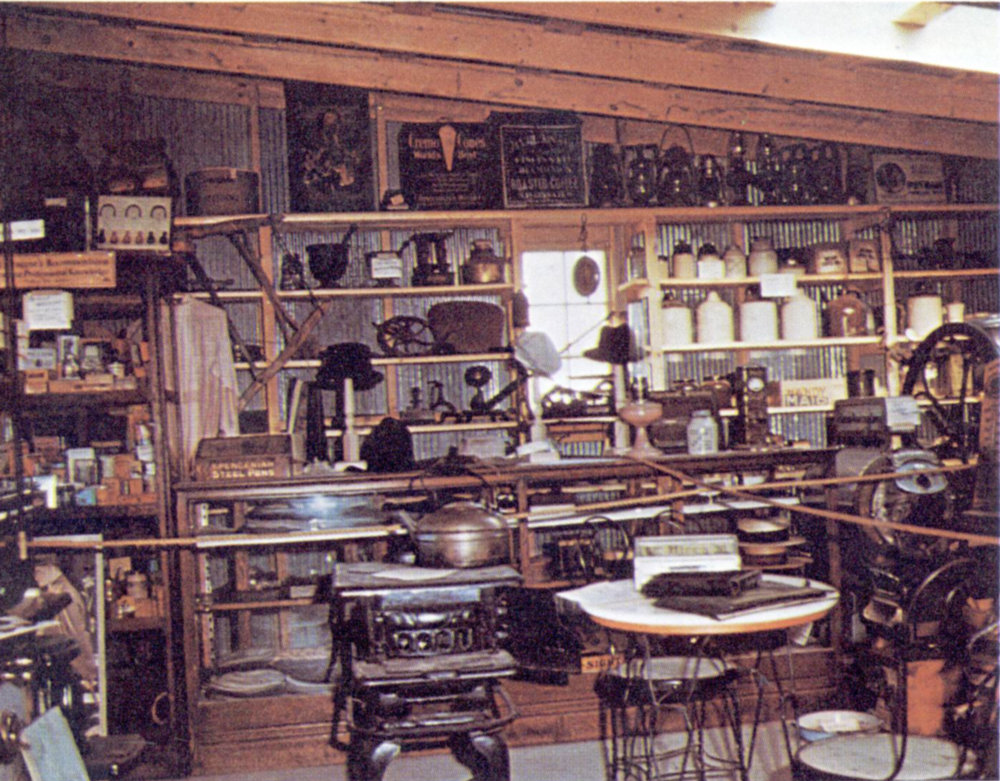
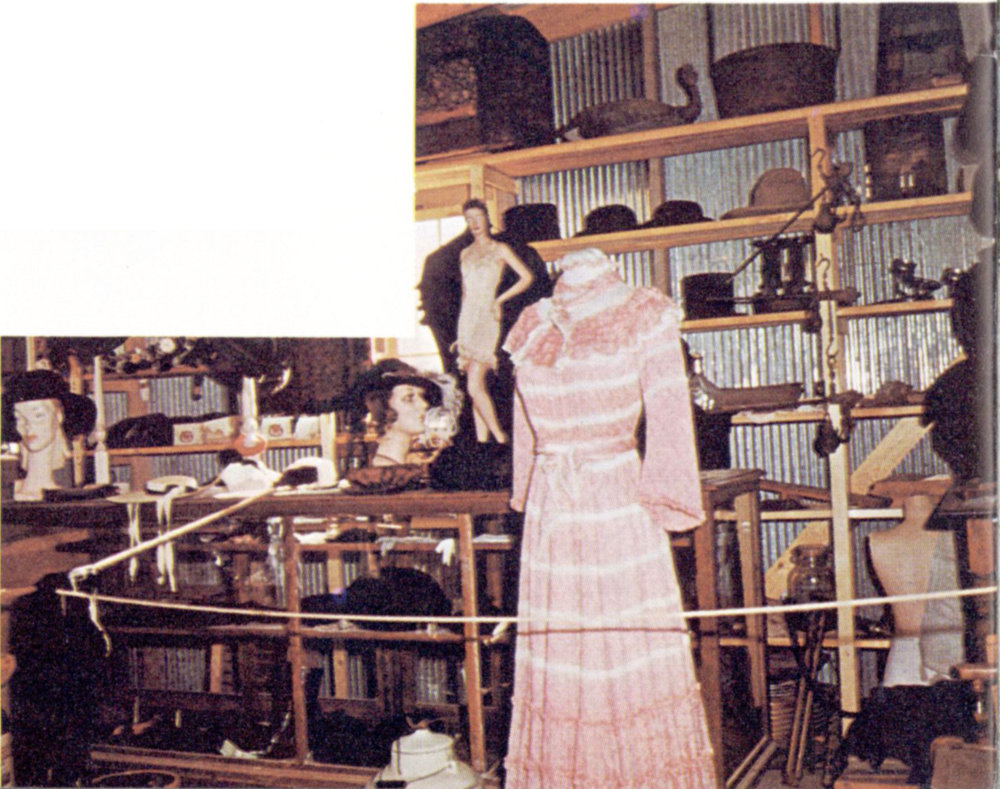
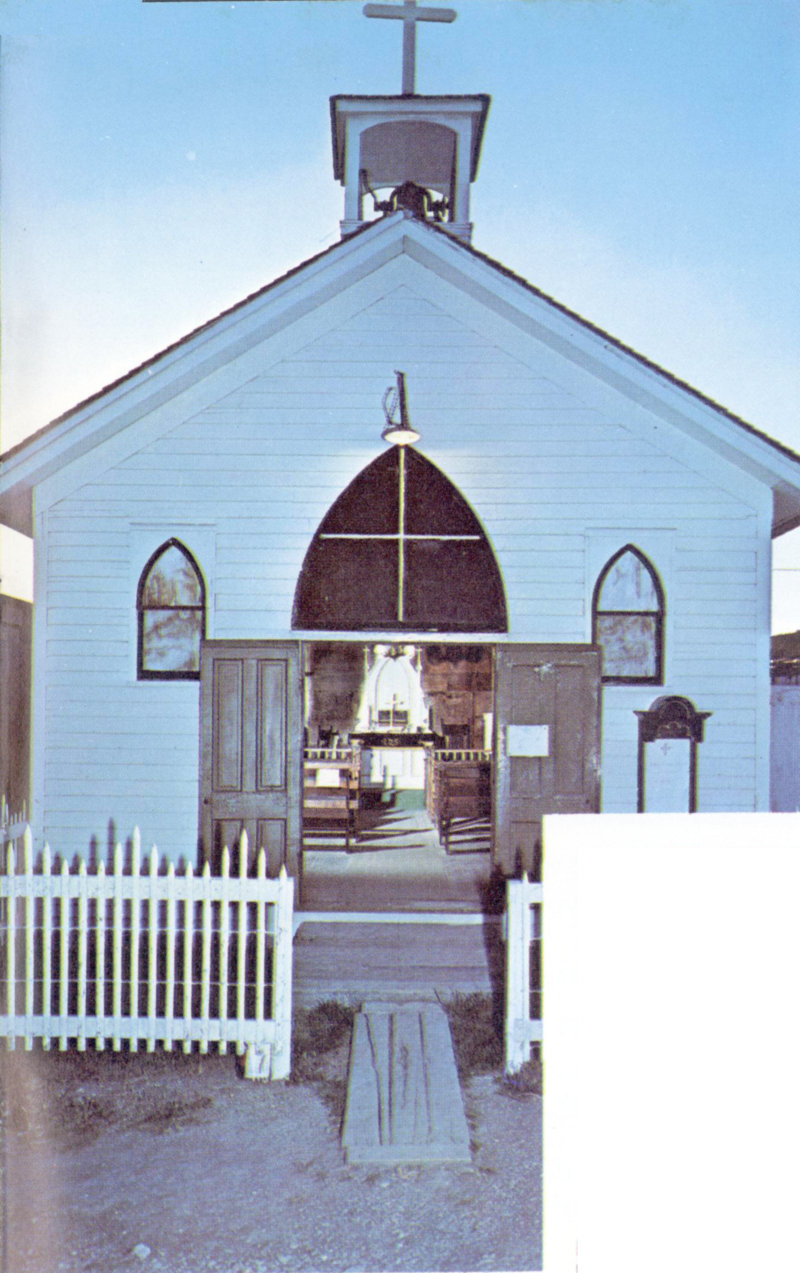
Many a pioneer worshipped his Maker in this small country church rescued from abandonment and ultimate destruction. It is complete with hymnals, prayer books, altar and other original furnishings.

This authentic one-room school house is complete with books, desks, and Regulator wall clock.
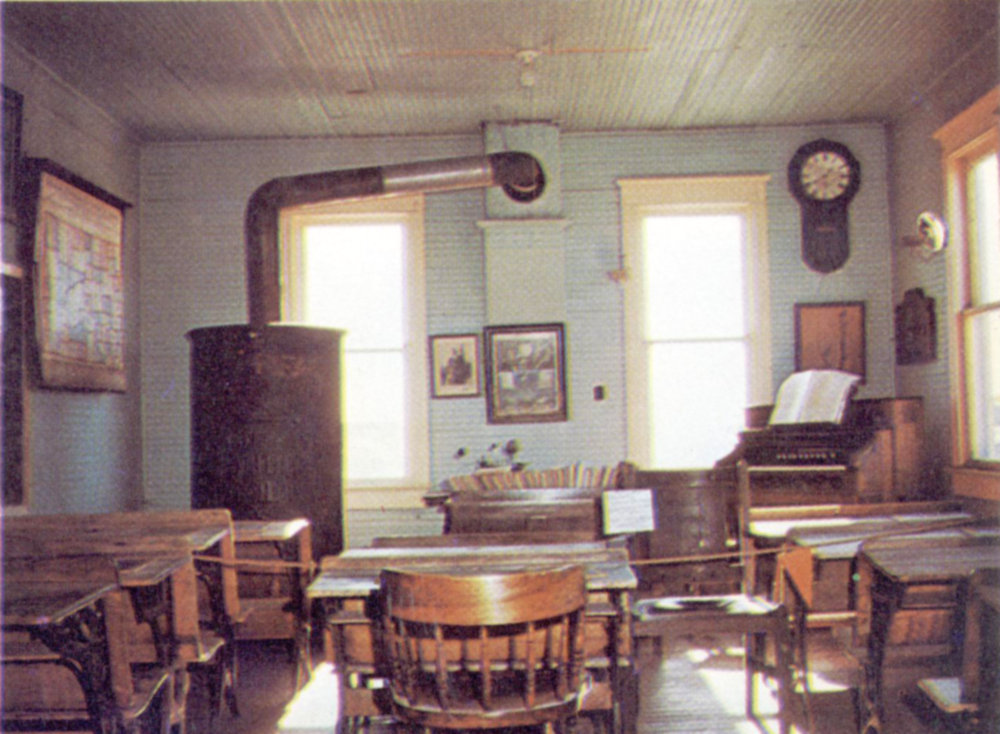
Note the double desk and the old stove. Children of pioneer days walked or rode horseback for many miles each day to attend classes.

Made by Wurlitzer about 40 years ago, this is the world’s largest Concert Band Organ.
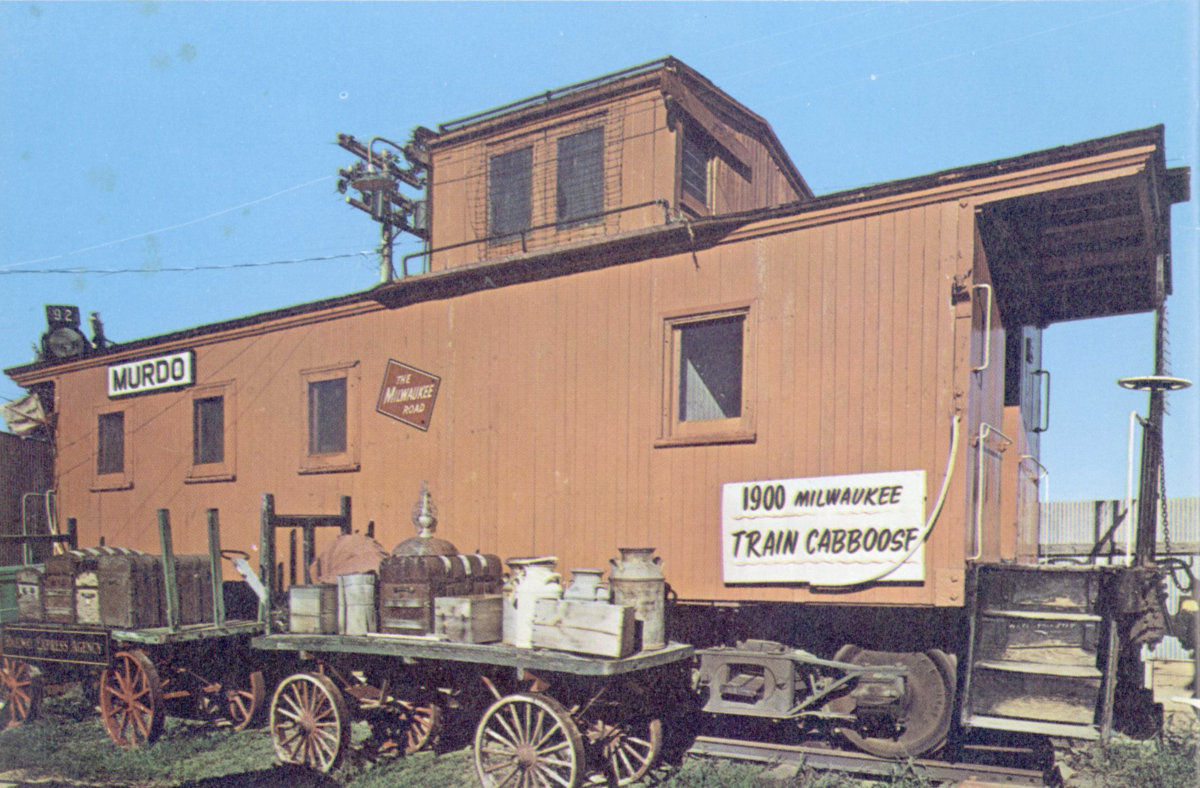
All visitors seem to enjoy climbing up to the cab of the old C.M & St. P. R.R. caboose. This old veteran of steam-driven railroad days was used when South Dakota was first homesteaded. It is completely furnished with authentic pot-bellied stove and other equipment of its day.
The PIONEER AUTO MUSEUM opened in May of 1954 with 25 cars and a single building. As time went on a collection of old farm machinery and tractors blossomed in back. And as old original buildings such as jails, schools, churches, banks and many others were doomed to replacement in the community, Mr. Geisler added yet another facet of olden day preservation to the museum. China, toys, glassware, lamps, musical antiquities and other things too numerous to mention here were added. So many things, in fact, that many buildings such as the general store, the church, and the school house are fully stocked and equipped with authentic original trappings. Today the museum boasts 25 buildings with over 200 vehicles plus thousands of other memorabilia. Because of Mr. Geisler’s fondness for Ford automobiles, a special building in the museum, Henry’s Ford Garage, contains only Fords. In 1956 Mr. Geisler sold the Chevrolet-John Deere Agency and purchased the Ford Agency in Murdo, which is managed by another son, Dave.
PIONEER AUTO MUSEUM is more than a mere tourist attraction. It is a tribute to a man and woman and their family who have had the foresight to preserve the past. The thousands of items to be seen in a fine state of preservation would have doubtless been lost to the dumps and junk piles. Instead posterity can visit and maybe “live a little” in the days of their forefathers in authentic surroundings.
Visit with Dick and John. They will be happy to give you interesting and expert information on anything in the PIONEER AUTO MUSEUM. They might even relate a few of the interesting and amusing tales of how the cars were found and moved from over 40 states to the PIONEER AUTO MUSEUM in Murdo, South Dakota.

1931 Packard Touring Car
This rare classic was the personal pride of its original owner, Tom Mix, hard-riding cowboy of movie fame. The classic features of this phaeton included wire wheels, side-mounted twin spares topped by rear-view mirrors, dual windshields and dual cowls.